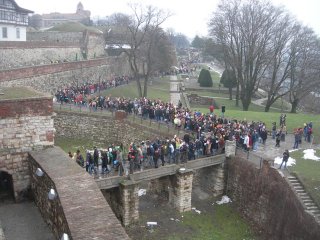 There's a shortcut I take when I'm walking to work. I leave the old section of Belgrade and cross the bridge over the Sava.
There's a shortcut I take when I'm walking to work. I leave the old section of Belgrade and cross the bridge over the Sava.I cut through my favorite place, Staro Sajmiste and I always see something new that's actually old.
Then, I follow the trolleys after they have crossed the older, steel, arched bridge from Belgrade into Novi Beograd -- New Belgrade.
Then, I follow a narrow connecting street that places me in the parking lot behind some of the modern, new buildings that face the west toward the more sterile New Belgrade.
It was along the fence that sort of separates this high tech business center from the Tijuana-like slums that adjoin and share the name of the original old fairgrounds, Staro Sajmiste, that I looked up and saw the first blossoms. They were small enough and far enough away from where anyone would be looking -- especially in this dividing line between the Yugo-yuppie rat racers and the cart-pushing, cardboard collectors who clean the old city of anything they can possibly recycle.
It reminded me of one of my favorite poems -- a poem written through the eyes of a British soldier who was enduring the monotonous training that goes on in spite of the arrival of spring.
Naming of Parts
by Henry Reed
Today we have naming of parts. Yesterday,
We had daily cleaning. And tomorrow morning,
We shall have what to do after firing. But today,
Today we have naming of parts.
Japonica
Glistens like coral in all of the neighboring gardens,
And today we have naming of parts.
This is the lower sling swivel. And this
Is the upper sling swivel, whose use you will see,
When you are given your slings. And this is the piling swivel,
Which in your case you have not got.
The branches
Hold in the gardens their silent, eloquent gestures,
Which in our case we have not got.
This is the safety-catch, which is always released
With an easy flick of the thumb. And please do not let me
See anyone using his finger. You can do it quite easy
If you have any strength in your thumb.
The blossoms
Are fragile and motionless, never letting anyone see
Any of them using their finger.
And this you can see is the bolt.
The purpose of this
Is to open the breech, as you see. We can slide it
Rapidly backwards and forwards: we call this
Easing the spring.
And rapidly backwards and forwards
The early bees are assaulting and fumbling the flowers:
They call it easing the Spring.
They call it easing the Spring: it is perfectly easy
If you have any strength in your thumb: like the bolt,
And the breech, and the cocking-piece, and the point of balance,
Which in our case we have not got; and the almond-blossom
Silent in all of the gardens and the bees going backwards and forwards,
For today we have naming of parts.

















 Several of my friends asked about were wondering why the media weren't describing the feelings of the people of Serbia as the funeral of Slobodan Milosevic nears. I can't answer the "why" question, but I've begun asking people I encounter about their feelings.
Several of my friends asked about were wondering why the media weren't describing the feelings of the people of Serbia as the funeral of Slobodan Milosevic nears. I can't answer the "why" question, but I've begun asking people I encounter about their feelings.

























